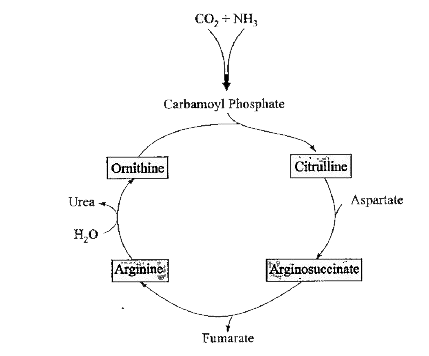Urea is produced in mammals from
A
Ammonia released by oxidative deamination
B
Oxidative deamination of purines
C
Breakdown of ornithine
D
Breakdown of arginine
Text Solution
The correct Answer is:D
Urea cycle was discovered by Krebs and Hanseleit.
Urea cycle takes place in liver cells.
In urea cycle, NH3 is converted into urea.. . In urea cycle, 2 molecules of NH3 and 1 molecule of CO2 is involved.
Urea cycle removes two waste products from the blood in liver, i.e. NH3 and CO2.
Urea (NH2−CO−NH2) has 2 amino (−NH2) groups, one derived from NH3 and other from aspartate.
C-atom of urea is supplied by CO2
One molecule of NH3 and one molecule of CO2 reacts to form carbamoyl phosphate. Carbamoyl phosphate reacts with ornithine to form citrulline. Citrulline reacts with aspartate to produce arginosuccinate. Arginosuccinate cleaves to give fumarate and arginine. Arginase cleaves to arginine to form urea and ornithine.
Ornithine is reused in urea cycle. Urea is transported to kidney for its removal.
3 amino acids participating in urea cycle are ornithine citurulline and argining

Urea is produced in mammals from breakdown of ar ginine,
|
Similar Questions
Knowledge Check
Urea is directly produced in mammals from
Aammonia released by oxidative deaminationBoxidative deamination of proteinsCbreakdown of ornithineDbreakdown of arginineUrea is directly produced in mammals from
AAmmonia released by oxidative deaminationBOxidative deamination of purinesCBreakdown of ornithineDBreakdwon of argininePhysioblogically urea is produced by the action of an enzyme
AUricaseBUreaseCArginaseDNone
Fill in the blanks.
Urea is produced in ............... by the deamination of extra ...............
View SolutionPhysiologically urea is produced by the action of an enzyme
View SolutionUrea is formed in liver from
View SolutionIdentify the sound producing organ in mammals.
View SolutionUrea is derived from
View Solution
